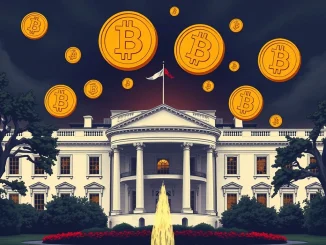
The world of digital assets has been buzzing with anticipation, waiting for clear rules of the road. For participants in the US crypto industry, this clarity is not just desired, it’s crucial for growth and innovation. The good news? A significant step has just been taken on Capitol Hill.
Understanding the Digital Asset Market Clarity Act
Recently, House Republicans introduced the Digital Asset Market Clarity Act. This isn’t just another piece of paper; it’s a substantial 236-page bill aiming to finally establish a comprehensive crypto regulation framework in the United States. Think of it as an attempt to build a sturdy bridge over the current murky waters of digital asset oversight.
At its core, the bill seeks to define roles and responsibilities, primarily dividing oversight between two key financial regulators:
- The Commodity Futures Trading Commission (CFTC)
- The Securities and Exchange Commission (SEC)
The intent is to provide much-needed certainty for businesses operating in the digital asset space, from exchanges to developers.
Who Regulates What? The CFTC and SEC Split
One of the most significant aspects of the Digital Asset Market Clarity Act is its proposed division of regulatory authority. For years, the debate has raged: are most digital assets commodities or securities? This bill attempts to settle that, at least from a legislative standpoint.
Here’s a simplified look at the proposed split:
- CFTC Primary Oversight: The bill grants the CFTC primary jurisdiction over digital commodity spot markets. This means assets deemed commodities (like Bitcoin and potentially others) would largely fall under the CFTC’s purview for spot trading activities.
- SEC Oversight: The SEC would retain oversight for digital assets deemed securities. The bill includes provisions for platforms to register with either the CFTC or the SEC, or potentially both, depending on the types of assets they list and the services they offer. This dual registration pathway is designed to accommodate the diverse nature of crypto businesses.
This proposed framework aims to provide a clearer path for digital asset platforms to operate legally within the US crypto industry, reducing the uncertainty that has often led to enforcement actions and stunted innovation.
Key Provisions You Need to Know
Beyond the fundamental CFTC/SEC split, the Digital Asset Market Clarity Act includes several other important provisions:
- Bank Secrecy Act (BSA) Compliance: Platforms would be required to comply with BSA obligations, which include Know Your Customer (KYC) and Anti-Money Laundering (AML) rules. This aligns the digital asset space with traditional financial regulations designed to prevent illicit finance.
- Exemptions for Certain DeFi and Wallet Providers: Recognizing the decentralized nature of some crypto activities, the bill includes exemptions for certain Decentralized Finance (DeFi) protocols and non-custodial wallet providers. This suggests an acknowledgment that not all participants in the ecosystem function like traditional financial intermediaries.
- Qualified Digital Asset Custodians: The bill proposes a new standard for qualified digital asset custodians. This is critical for ensuring the safety and security of customer funds held by platforms, a major concern for investor protection.
- Regulatory Studies: The bill mandates studies on areas like DeFi and Non-Fungible Tokens (NFTs). This indicates that lawmakers recognize the need for further understanding of these rapidly evolving sectors before potentially implementing specific rules.
- Implementation Timeline: If passed, the bill anticipates rule implementation within a year, suggesting a desire for relatively swift action once the legislative framework is in place.
Why Does This Bill Matter for the US Crypto Industry?
The introduction of the Digital Asset Market Clarity Act is significant for several reasons. For the US crypto industry, it represents a concrete legislative effort to move beyond debate and towards establishing clear, predictable rules.
Benefits could include:
- Increased Innovation: With regulatory certainty, companies may be more willing to invest and innovate in the US.
- Enhanced Investor Protection: Clear rules, BSA compliance, and custodian standards can provide better safeguards for individuals participating in the market.
- Greater Institutional Adoption: Regulatory clarity is often cited as a prerequisite for larger financial institutions to enter the digital asset space more significantly.
- Competitive Edge: Establishing a clear framework could help the US compete globally as a hub for digital asset businesses.
However, challenges remain. The bill needs to navigate the complex legislative process, potentially facing opposition or calls for amendments. The specific details of how the CFTC and SEC will implement their respective roles, and how assets will be classified, will also be critical.
What’s Next for Crypto Legislation?
The Digital Asset Market Clarity Act doesn’t exist in a vacuum. It follows previous legislative attempts, such as the FIT21 Act, which also aimed to clarify crypto regulation. Furthermore, it runs parallel to ongoing efforts in the Senate to pass a dedicated stablecoin bill.
A key question now is whether these separate initiatives could converge. CoinDesk reported that there’s speculation about the possibility of the House’s broader digital asset bill and the Senate’s stablecoin focus merging into a larger legislative package later this year. This potential convergence highlights the dynamic nature of crypto policy in Washington.
For anyone involved in the US crypto industry, staying informed about the progress of this bill and related legislative efforts is crucial. It represents a potential turning point in how digital assets are regulated in the United States.
Compelling Summary
The introduction of the Digital Asset Market Clarity Act by House Republicans marks a pivotal moment in the push for clear crypto regulation in the United States. By proposing a framework that primarily gives the CFTC oversight of digital commodity spot markets and provides registration pathways under both the CFTC and SEC, the bill aims to bring much-needed certainty to the US crypto industry. With provisions covering BSA compliance, DeFi/wallet exemptions, and custodian standards, it addresses key aspects of the market. While its passage and final form are yet to be determined, this comprehensive bill signals a serious legislative effort to create a predictable environment for digital assets, potentially unlocking significant innovation and investment while enhancing consumer protection.



